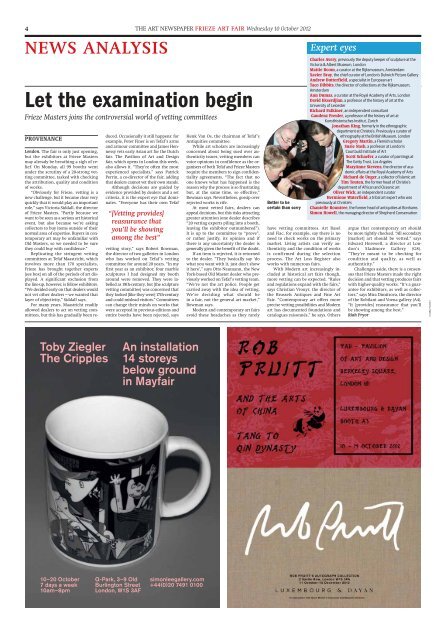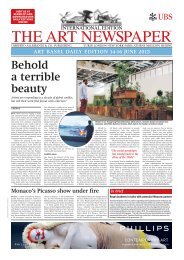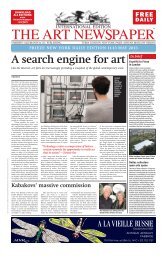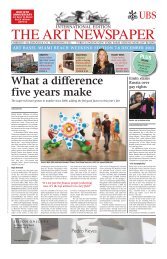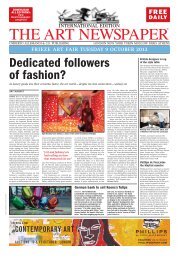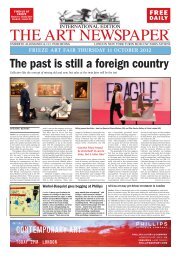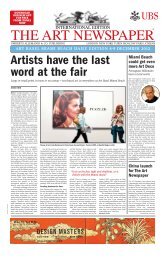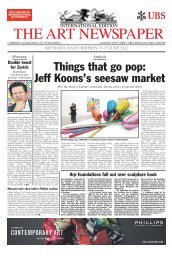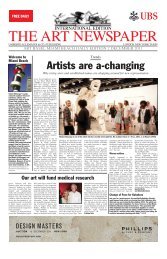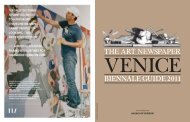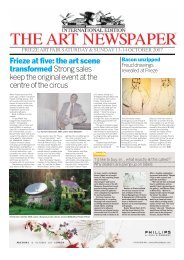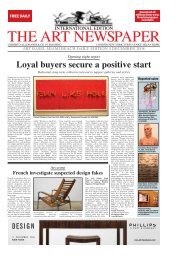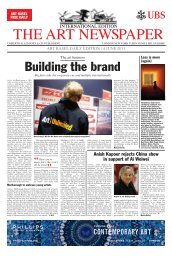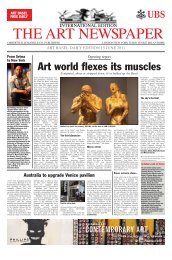Issue 2 - The Art Newspaper
Issue 2 - The Art Newspaper
Issue 2 - The Art Newspaper
Create successful ePaper yourself
Turn your PDF publications into a flip-book with our unique Google optimized e-Paper software.
4<br />
NEWS ANALYSIS<br />
THE ART NEWSPAPER FRIEZE ART FAIR Wednesday 10 October 2012<br />
Let the examination begin<br />
Frieze Masters joins the controversial world of vetting committees<br />
PROVENANCE<br />
London. <strong>The</strong> fair is only just opening,<br />
but the exhibitors at Frieze Masters<br />
may already be breathing a sigh of relief.<br />
On Monday, all 99 booths went<br />
under the scrutiny of a 20-strong vetting<br />
committee, tasked with checking<br />
the attribution, quality and condition<br />
of works.<br />
“Obviously for Frieze, vetting is a<br />
new challenge, but it became clear very<br />
quickly that it would play an important<br />
role,” says Victoria Siddall, the director<br />
of Frieze Masters. “Partly because we<br />
want to be seen as a serious art historical<br />
event, but also because we’re asking<br />
collectors to buy items outside of their<br />
normal area of expertise. Buyers in contemporary<br />
art may be unfamiliar with<br />
Old Masters, so we needed to be sure<br />
they could buy with confidence.”<br />
Replicating the stringent vetting<br />
committees at Tefaf Maastricht, which<br />
involves more than 170 specialists,<br />
Frieze has brought together experts<br />
[see box] on all of the periods of art displayed.<br />
A significant exclusion from<br />
the line-up, however, is fellow exhibitors.<br />
“We decided early on that dealers would<br />
not vet other dealers—we wanted that<br />
layer of objectivity,” Siddall says.<br />
For many years, Maastricht readily<br />
allowed dealers to act on vetting committees,<br />
but this has gradually been re-<br />
duced. Occasionally it still happens: for<br />
example, Peter Finer is on Tefaf’s arms<br />
and armour committee and James Hennessy<br />
vets early Asian art for the Dutch<br />
fair. <strong>The</strong> Pavilion of <strong>Art</strong> and Design<br />
fair, which opens in London this week,<br />
also allows it. “<strong>The</strong>y’re often the most<br />
experienced specialists,” says Patrick<br />
Perrin, a co-director of the fair, adding<br />
that dealers cannot vet their own stands.<br />
Although decisions are guided by<br />
evidence provided by dealers and a set<br />
criteria, it is the expert eye that dominates.<br />
“Everyone has their own Tefaf<br />
“[Vetting provides]<br />
reassurance that<br />
you’ll be showing<br />
among the best”<br />
vetting story,” says Robert Bowman,<br />
the director of two galleries in London<br />
who has worked on Tefaf’s vetting<br />
committee for around 20 years. “In my<br />
first year as an exhibitor, four marble<br />
sculptures I had designed my booth<br />
around were removed. <strong>The</strong>y were labelled<br />
as 19th-century, but [the sculpture<br />
vetting committee] was concerned that<br />
they looked [like they were] 17th-century<br />
and could mislead visitors.” Committees<br />
can change their minds on works that<br />
were accepted in previous editions and<br />
entire booths have been rejected, says<br />
Henk Van Os, the chairman of Tefaf’s<br />
Antiquities committee.<br />
While art scholars are increasingly<br />
concerned about being sued over authenticity<br />
issues, vetting members can<br />
voice opinions in confidence as the organisers<br />
of both Tefaf and Frieze Masters<br />
require the members to sign confidentiality<br />
agreements. “<strong>The</strong> fact that no<br />
one knows what has happened is the<br />
reason why the process is so frustrating<br />
but, at the same time, so effective,”<br />
Bowman says. Nevertheless, gossip over<br />
rejected works is rife.<br />
At most vetted fairs, dealers can<br />
appeal decisions, but this risks attracting<br />
greater attention (one dealer describes<br />
“20 vetting experts piling into a booth,<br />
leaving the exhibitor outnumbered”).<br />
It is up to the committee to “prove”,<br />
or rather justify, its opinion and if<br />
there is any uncertainty the dealer is<br />
generally given the benefit of the doubt.<br />
If an item is rejected, it is returned<br />
to the dealer. “<strong>The</strong>y basically say ‘do<br />
what you want with it, just don’t show<br />
it here’,” says Otto Naumann, the New<br />
York-based Old Master dealer who previously<br />
worked on Tefaf’s vetting team.<br />
“We’re not the art police. People get<br />
carried away with the idea of vetting.<br />
We’re deciding what should be<br />
in a fair, not the general art market,”<br />
Bowman says.<br />
Modern and contemporary art fairs<br />
avoid these headaches as they rarely<br />
Better to be<br />
certain than sorry<br />
Expert eyes<br />
have vetting committees. <strong>Art</strong> Basel<br />
and Fiac, for example, say there is no<br />
need to check works on the primary<br />
market. Living artists can verify authenticity<br />
and the condition of works<br />
is confirmed during the selection<br />
process. <strong>The</strong> <strong>Art</strong> Loss Register also<br />
works with numerous fairs.<br />
With Modern art increasingly included<br />
at historical art fairs though,<br />
more vetting can be expected. “Rules<br />
and regulations expand with the fairs,”<br />
says Christian Vrouyr, the director of<br />
the Brussels Antiques and Fine <strong>Art</strong><br />
Fair. “Contemporary art offers more<br />
precise vetting possibilities and Modern<br />
art has documented foundations and<br />
catalogues raisonnés,” he says. Others<br />
Charles Avery, previously the deputy keeper of sculpture at the<br />
Victoria & Albert Museum, London<br />
Mattie Boom, a curator at the Rijksmuseum, Amsterdam<br />
Xavier Bray, the chief curator of London’s Dulwich Picture Gallery<br />
Andrew Butterfield, a specialist in European art<br />
Taco Dibbits, the director of collections at the Rijksmuseum,<br />
Amsterdam<br />
Ann Dumas, a curator at the Royal Academy of <strong>Art</strong>s, London<br />
David Ekserdjian, a professor of the history of art at the<br />
University of Leicester<br />
Richard Falkiner, an independent consultant<br />
Gaudenz Freuler, a professor of the history of art at<br />
Kunsthistorisches Institut, Zurich<br />
Jonathan King, formerly in the ethnographic<br />
department at Christie’s. Previously a curator of<br />
ethnography at the British Museum, London<br />
Gregory Martin, a Flemish scholar<br />
Susie Nash, a professor at London’s<br />
Courtauld Institute of <strong>Art</strong><br />
Scott Schaefer, a curator of paintings at<br />
<strong>The</strong> Getty Trust, Los Angeles<br />
MaryAnne Stevens, the director of academic<br />
affairs at the Royal Academy of <strong>Art</strong>s<br />
Richard de Unger, a collector of Islamic art<br />
Tim Teuten, the former head of Christie’s<br />
department of African and Oceanic art<br />
Oliver Wick, an independent curator<br />
Hermione Waterfield, a tribal art expert who was<br />
previously at Christie’s<br />
Chantelle Rountree, the former head of antiquities at Bonhams<br />
Simon Howell, the managing director of Shepherd Conservation<br />
argue that contemporary art should<br />
be more tightly checked. “All secondary<br />
[market] art should be vetted,” says<br />
Edward Horswell, a director at London’s<br />
Sladmore Gallery (G8).<br />
“<strong>The</strong>y’re meant to be checking for<br />
condition and quality, as well as<br />
authenticity.”<br />
Challenges aside, there is a consensus<br />
that Frieze Masters made the right<br />
decision and that vetting produces fairs<br />
with higher-quality works. “It’s a guarantee<br />
for exhibitors, as well as collectors,”<br />
says Mira Dimitrova, the director<br />
of the Robilant and Voena gallery (A4).<br />
“It [provides] reassurance that you’ll<br />
be showing among the best.”<br />
Riah Pryor<br />
© ISABEL POUSSET


